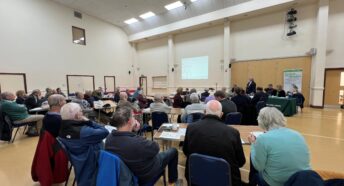Laying the myths to rest: Canterbury crisis shows how desperate government policy and housebuilder attitudes are making homes unaffordable... and destroying our countryside

In this concerning piece, Richard Thompson, CPRE Kent planner, spears the ridiculous notion that simply building more houses will make them more affordable. He highlights the critical need to revisit the standard methodology for calculating housing if we are to rethink how we deliver truly affordable housing in a way that doesn’t sacrifice greenfield land.
An article on Kent Online this month highlighted the absurdity of government thinking that private-sector housebuilding alone will solve the housing affordability crisis.
The fact is, while ever-more houses are being built, the gap between house prices and earnings is still increasing, while much-needed affordable housing is simply not being built.
A stark example of this national policy failure at the local level can be found by looking in detail at the provision of affordable housing in the Canterbury district over the last 10 years.
Within Canterbury district, the average cost of a new-build dwelling has increased from £160,476 in September 2011 to £317,381 in September 2021 [1].
That’s almost a doubling of prices in 10 years.
Unsurprisingly, this market price is not affordable for most Canterbury residents. In fact, Canterbury City Council itself considers an income of more than £75,000 would be required to buy a house at this price without assistance [2].
It believes this equates to only 2 per cent of the population of Canterbury. Or, put another way, 98 per cent of Canterbury residents cannot afford a new-build home on the open market in the district on their incomes alone.
Assistance therefore comes via affordable home-ownership ‘products’ such as Help to Buy and shared-ownership schemes. These all fall within the formal planning definition of affordable housing as set out in national planning policy in the National Planning Policy Framework (NPPF). However, many of these affordable home-ownership products are still not actually affordable to most Canterbury residents.
The table below assesses each of the different affordable home-ownership products against the income required to afford them and then considers what percentage of the district would not be able to afford these products [3].
| Affordable Home Ownership Options Scheme | Income Required | Households Unable to Afford (all households) | Households Unable to Afford (private renters) |
| Help to Buy: Equity Loan (20%) | £67,018 | 95% | 98% |
| Help to Buy: Shared Ownership (50%) | £60,419 | 93% | 97% |
| First Homes (30% discount) | £52,567 | 90% | 94% |
| Help to Buy: Shared Ownership (25%) | £50,790 | 90% | 93% |
| Rent to Buy (80% of median rent) | £23,323 | 32% | 46% |
Yes, you have read correctly – it is the council’s own assessment that 98 per cent of Canterbury residents who currently rent are considered unable to afford the government’s flagship Help to Buy: Equity Loan scheme. Across all the schemes, at best, only 54 per cent of current renters would be able to afford the ‘cheapest’ rent-to-buy route to home ownership.
For those left, the only option is to rent. However, paying open-market rents is deemed unaffordable for 45 per cent of households in Canterbury.
For this group, there are two types of rental products that fall within the formal planning definition of ‘affordable housing’. The first is affordable rent, which in Canterbury is some 86-97 per cent of the cheapest market rents, ie not necessarily that affordable and subject to usual market price rises. The second is the social rent, which is set according to a complex formula but is typically between 50 per cent and 60 per cent of market rent. This is the cheapest route to accommodation and in Canterbury is about £435 a month.
It is unsurprising then that the council considers the most pressing affordable housing need for Canterbury is for the genuinely affordable social rent homes. It considers 231 social rent homes are now required a year. There is then a lesser need for affordable home-ownership products (156 required a year) and then affordable rent homes (77 required a year). In total that’s 464 affordable homes required a year in Canterbury.
However, Canterbury City Council, like most Kent councils, does not generally build houses. Rather, the current model is that a developer is expected to use a small proportion of the financial gain it gets from a grant of planning permission to provide a certain number of affordable houses alongside the market houses it sells. In Canterbury, the target is that 30 per cent of all homes built should meet the NPPF planning definition of affordable (though until 2017 was set at 35 per cent for the Canterbury Urban Area).
So how many affordable homes have been provided in Canterbury under this model over the last 10 years? The next table sets out how many of each type of affordable house has been built over this period and quite clearly shows it to be nowhere near enough.
| Year | Affordable rent | Affordable home ownership | Social rent | Total |
| 2011/12 | 18 | 33 | 93 | 144 |
| 2012/13 | 10 | 53 | 58 | 121 |
| 2013/14 | 10 | 10 | 50 | 70 |
| 2014/15 | 40 | 0 | 0 | 40 |
| 2015/16 | 20 | 30 | 0 | 50 |
| 2016/17 | 38 | 10 | 0 | 48 |
| 2017/18 | 9 | 36 | 0 | 45 |
| 2018/19 | 19 | 37 | 0 | 56 |
| 2019/20 | 40 | 55 | 44 | 139 |
| 2020/21 | 35 | 22 | 0 | 57 |
| Total | 239 | 286 | 245 | 770 |
That’s barely a current year’s requirement of social rent homes built in total over the last 10 years. Amazingly, in six out of 10 years not a single social rent home was built. With an overall total of 6,097 new homes having been built within the Canterbury district across this period, that equates to 12.6 per cent affordable homes built across all types against the target of 30-35 per cent.
So why are the required affordable houses not being built by the development industry? For many, the main reason is that current government policies allow levels of affordable housing to be reduced if a development is not deemed ‘viable’.
In the simplest terms, a development is not deemed viable if it can be demonstrated a developer would make a profit of less than 15-20 per cent once all set costs are accounted for. Significantly, one such set cost is an agreed premium to buy the land by the developer that is usually 20 times the existing value of the land though can be as much as 40 times! [4] Added to this, the greater the perceived need for housing, the lower the ability of the council to negotiate, particularly if the council is subject to the ‘tilted balance’ presumption in favour of granting planning permission.
While the intricacies of viability appraisals are a topic of concern in themselves, the fact is housebuilder profits are soaring all the while the current system is not delivering affordable homes on the ground.
In 2021, when not a single social rent home was built in Canterbury, the four biggest UK housebuilders – Persimmon, Berkeley, Taylor Wimpey and Barratt Homes – reported pre-tax profits of £784 million, £504 million, £492 million and £264 million respectively.
Despite this, the development industry maintains the problem is simply that not enough homes are being given planning permission. The argument goes that if they were given more permissions to build more houses, then of course more affordable houses would be delivered and market housing would become more affordable.
While the above record in Canterbury suggests otherwise, this argument is flawed for other reasons.
For starters, it can be argued that there is already sufficient planning permission or land available to build on. In Canterbury, there is either an existing planning permission or an identified Local Plan land allocation for 12,334 new homes [5]. Specifically with respect to affordable housing, as of March 2021, there were 1,757 social/affordable rental units with permission in the pipeline. This is more than double the number of affordable homes built in Canterbury over the last 10 years. Despite this, Canterbury has just failed the government’s Housing Delivery Test for not building enough houses, meaning the district is now subject to the presumption that planning permission will be given even if in conflict with the adopted Local Plan. As pointed out by CPRE Kent just last month, this is absurd.
There is also the small matter that housebuilders are quite simply not going to build at a level that over-supplies a local housing market, forcing them to reduce prices and lower profits.
The absorption concept was most recently highlighted by Sir Oliver Letwin in his government-commissioned independent review of buildouts. Here he found the “fundamental driver of buildout rates once detailed planning permission is granted for large sites appears to be the ‘absorption rate’ – the rate at which newly-constructed homes can be sold into (or are believed by the housebuilder to be able to be sold successfully into) the local market without materially disturbing the market price” [6]. Alongside this, there are practical constraints such as the current labour and materials shortages.
However, and perhaps most significantly, it is housing market demand rather than need that drives affordability. Currently this demand is being fed as much by monetary policy and financial markets as by physical shortages. Low interest rates and readily available mortgage credit, coupled with state assistance policies such as Help to Buy Equity Loans, are arguably allowing those already in the position to buy a house to offer ever more. They are often bidding against others in a similar position, pushing the market prices up in the process. Meanwhile, those not already in a position to buy get left even further behind.
So why does this matter?
At the superficial level, CPRE Kent and other similar organisations are often accused of denying local communities much-needed housing when we object to yet more greenfield land being lost to market housing. Taking the Canterbury example, however, the council itself is accepting the new-build market housing dominating the supply is simply not affordable to most existing residents in the district. For those existing residents, they are losing greenfield land important to them to satisfy a wider market demand rather than for their direct benefit.
At the far more important level, though, this matters because the government’s current standard method for calculating how many houses a district needs is directly linked to housing affordability within that district. That is, the bigger the gap between new-build house prices and median earnings in a district, the higher the housing number for that district is. And the government rationale for this is that by building more houses, the cost of housing will come down…
This problem is increasingly urgent. The government affordability data are released on an annual basis, usually in March. On release of this data, housing targets for each council can change overnight. With it reasonable to assume that the gap between houses prices and earnings is likely to have widened over the last year for much of Kent, the consequences for the county could be dire.
The need to revisit the standard methodology for calculating housing is therefore urgent. The need to rethink how we deliver truly affordable housing in a way that doesn’t sacrifice greenfield land to bolster developer profits is arguably even more urgent.
References
[1] UK House Price Index – HM Land Registry Open Data
[2] Canterbury City Council Housing Needs Assessment 2021 –https://drive.google.com/drive/u/0/folders/1BCdWC6ME7X_b6szgA1E5knDlsta1ooTY
[3] again taken from the September 2021 Canterbury Housing Needs Assessment
[4] See – https://lichfields.uk/media/6509/fine-margins_viability-assessments-in-planning-and-plan-making.pdf
[5] Canterbury Authority Monitoring Report 2020-2021
[6] Sir Oliver Letwin’s final report – https://www.gov.uk/government/publications/independent-review-of-build-out-final-report
Tuesday, February 15, 2022
- A number of important documents have yet to emerge. For example, a rigorous transport plan and a finalised air-quality assessment. The latter is critical given that allocations at Teynham will feed extra traffic into AQMAs.
- There seems to be no coherent plan for infrastructure delivery – a key component of the plan given the allocations being proposed near the already crowded Junction 7.
- There seems to have been little or no cooperation with neighbouring boroughs or even parish councils within Swale itself.
The removal of a second consultation might have been understandable if this final version of the plan were similar to that being talked about at the beginning of the consultation process. It is, however, radically different in the following ways:
- There has been a major shift in the balance of housing allocations, away from the west of the borough over to the east, especially around the historic town of Faversham. This is a move that raises many concerns.
- A new large allocation, with accompanying A2 bypass, has appeared around Teynham and Lynsted, to which we are objecting.
- Housing allocations in the AONB around Neames Forstal that were judged “unsuitable” by the council’s own officers have now appeared as part of the housing numbers.
- Most of the housing allocations being proposed are on greenfield sites, many of them on Grade 1 agricultural land – a point to which we are strongly objecting.
Concerns about the rush to submit the plan
The haste with which the plan is being prepared is especially worrying given the concentration of housing in Faversham. If the town is to take a large amount of new housing, it is imperative that the policies concerning the area are carefully worked out to preserve, as far as possible, the unique nature of the town. The rush to submit the plan is likely to prove detrimental.
As Swale does not have a five-year land housing supply, it is open to speculative development proposals, many of which would run counter to the ideas contained in the current plan. Some are already appearing. This is a common situation, and one that, doubtless, is a reason behind Swale’s haste.
Our overriding fear, however, is that this emphasis on haste is ultimately going to prove counterproductive. This is because it is our view that the plan, in its current form, is unlikely to pass independent examination. We are urging Swale to listen to and act upon the comments being made about the plan and to return the plan to the council with appropriate modifications before submitting it to the Secretary of State.
Essentially, this means treating the current consultation not as the final one but as the ‘lost’ second consultation.
The consultation ends on Friday 30 April and we strongly urge residents to make their opinions known if they have not already done so.
Further information








